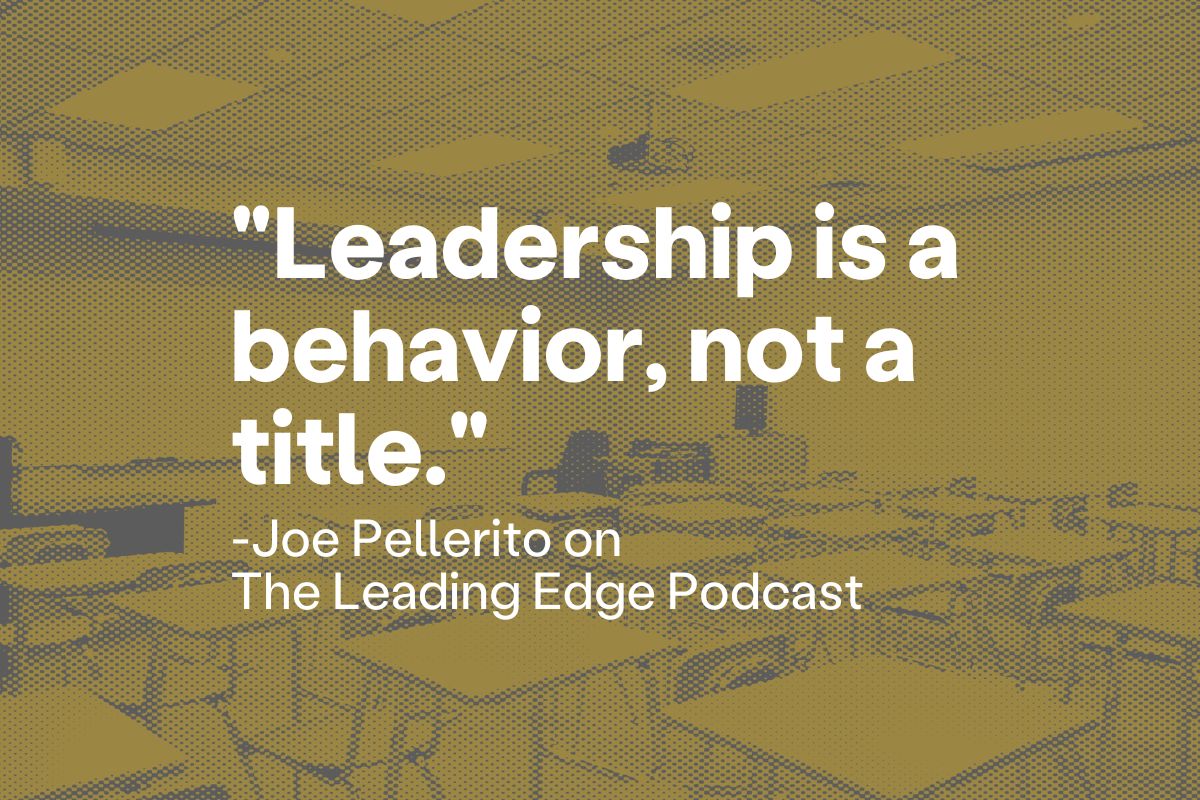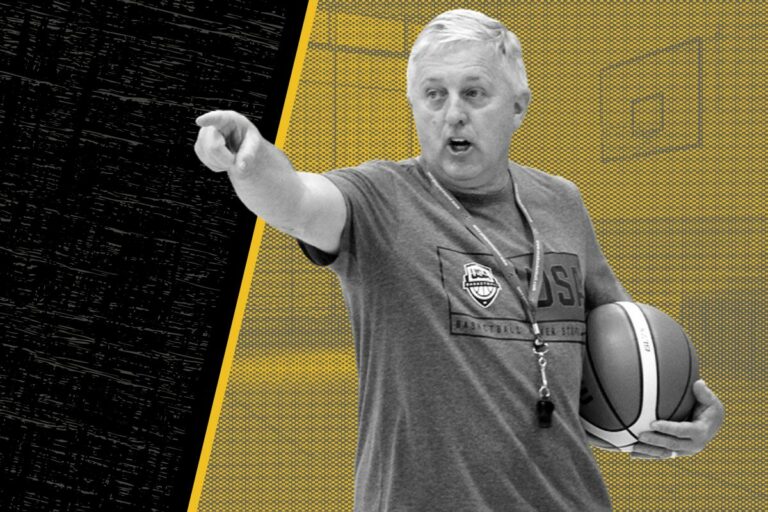How Relationship Building Can help your Program
- No matter your role, ultimately, all leaders are coaches.
- You earn the right to "coach" by establishing relational capacity.
- Permission to fail is a key piece of success.
Joe Pellerito has been in education for over 20 years. He has been a teacher and a diving coach. For the last 13 years has been a leadership development strategist with the Capturing Kids’ Hearts organization. He teaches leadership through relationship building to educators, coaches, and school leaders to unlock staff and student performance.
Listen to the entire conversation below on the Leading Edge podcast:
Q: You work with students, teachers, principals, staff, and coaches, how do you get all of them all on the same page and excited about improving?
Many years ago, I went through the Capturing Kids’ Hearts process. What I learned is that whoever I’m working with, whether it’s teachers, administrators, coaches, or students, they are all the coach.
During my training, I’ll say, ”Raise your hand if you’re a coach in here.” And of course, the first couple of hands that come up are the basketball and the football coaches hands. Then I ask again, “All right, raise your hand if you’re a coach.” I keep asking that question, until I say, “Hey, everyone’s hands should be up right now.”
That’s the sweet spot, to get them all to realize they all are coaches and leaders. Now the next step is to get them to actually connect with each other and learn to call out the best in each other so they can go farther. My challenge is, “How can I get that interconnectedness flyin’?”
Q: When you are going for that culture of “interconnectedness,” where do you start?
You build a culture by relationship building and interconnectedness between people. That has to be intentional. Once we know each other as a team we can get more vulnerable and actually communicate and disclose things. You know a quiet group is not necessarily a safe group. I see it more as how do we lower anxiety? How do we build that relational capacity so we can get real work done?
The model I use in my trainings is called the Excel Model. Excel is a core piece of the Capturing Kids’ Hearts program. The acronym, E-X-C-E-L stands for: Engage, Explore, Communicate, Empower, Launch.
“E” is Engage
As a coach or teacher, I want to think, “How do I get them engaged?”
Meaning that I understand, when my group arrives, the game has already started. For example, when I was a diving coach, I would tell my girls they aren’t necessarily being scored just on how they enter the water. They are being scored on how they approach the board.
“X” is X-plore
The “X” stands for “explore”. I want to discover the needs of the group before I communicate with them what we are going to do for the day — to take their temperature and see where they’re at emotionally and energetically. The technique I use, “Good Things.”
For example, when I coached the girls’ diving team, I’d let them do their warm-ups, and then I’d say to them, “All right, let’s see where we’re at. Let’s do some good things.” So, I’d expect each one of them to share a “good thing” that happened recently for them. It can be something big in their life that is going well and they feel good about, or something simple and small from their day.
This exercise not only helps with building relationships — learning about each other’s interests and getting excited for each other about something positive. It also helps to build what I call relational capacity. Relational capacity is a depth of relationship that allows me to coach them hard because I have earned it.
“C” is for Communicate
Now that we’ve connected through the Explore step, I can communicate as the leader of the group.
This is pretty straight-forward and clear, “What are our goals for the day?” If it’s my diving squad, we’re talking about the meet that is coming up, what need to do, what is expected of each other.
That’s the communicate, “this is what we gotta do…”
“E” is to Empower
So, after you have built connection and communicated clearly, it’s time to empower them.
You have communicated the goals and maybe some of the plan, now let them decide what they are going to do with that. Empower them.
Let them have some choice in what they are going to do with that information. Including even a small amount of choice for your group can go a long way.
“L” is Launch
The launch is just that. Whether it’s a practice, a classroom, or a call, we’re going to end our meeting with a purpose. Some teachers and coaches might not see it as a launch, but it is. They know how to wrap things up strong so that their students or players are thinking about it as they go forward with class or practice.
Find out more about the “EXCEL model and Capturing Kid’s Hearts organization at www.ckh.org
Q: The EXCEL process seems great, and applicable across the board. How has using it and teaching it impacted your view of leadership and the role of a leader?
I believe Leadership is a behavior, not a title. I go in and live the Excel process before I even teach it.
The Excel process does a lot more than you might think. It isn’t just about being warm and fuzzy. We are creating entry points to connection and relationship building. If you don’t care about me and I don’t care about you, why would we care to help each other out? I don’t just mean that as a coach. I mean that even between my athletes. If they don’t know each other, how likely are they gonna help each other out? How likely are they gonna ask for help from their teammate?
The Capturing Kid’s Hearts process has been around for 30 years. It’s amazing to me how I’ve seen that process proven in a variety of situations. I’ve gone into many situations where I don’t have any idea what the conversation will be. Just writing the Excel model down and the questions I am going to ask gives me a model that works. Even when I’m going into a situation that I know very little about. It gives me the confidence to know that I’ve got this. I can just walk in and go.
The process is called Capturing Kids’ Hearts, but it’s an adult process. I can’t tell you how many times at the end of the training teachers come up and say, “This really wasn’t about the kids, was it?” This is about leadership, leadership behavior, building relationships, and a way of being.
Q: What other tools do you leverage as part of the Capturing Kid’s Hearts program?
Another thing we use is called Leadership Scales. All of us have different wiring when it comes to our gifts and limitations. Two of those qualities on our Leadership Scales are nurturing and criticality. The better we understand our scales, the better we will be at effective relationship building.
Nurturing isn’t always good
On the nurturing scale, let’s say someone is a nine out of ten. High nurturers like to make people comfortable. They like to fix things for people. They tend to put other people’s needs above their own. Helping people comes naturally to them, and they are going to smile more easily than low nurturers. They almost have to nurture because it actually does something for them. At some point, that can actually become a hindrance.
Over-nurturing can become a limitation. If a high nurturer enables someone, is that really helping them? Low nurturers are sometimes seen as people who hurt people in the short run. High nurturers can hurt people in the long run.
Being Critical isn’t always bad
Then there’s the criticality scale. Criticality is more outward. They may have high standards and push in. Someone who scores nine out of ten on this may think this is a bad thing. However, it is not a matter of what you are, but when you are. Sometimes it is a gift to call things out, expect more, and have higher standards.
Someone low on criticality may avoid conflict. In that case, they are not helping anybody. Have you ever been in a room where everyone knows the issue and no one is talking about it? What does that do to the anxiety of a group? There are times when calling out a situation or a person is productive.
I’m just bringing up two of these skills. There are many other skills we use in the Leadership Scales tool.
Q: How do you decide what leadership style will work the best in any given situation?
Ultimately, I go in with more questions than I go in with an agenda.
How many times have you been under leadership where the behavior of the leader is questionable? So often a leader, coach, or teacher may just go in and just say, “Here’s what you need. Here’s what we’re gonna do and how we’re gonna do it.” Whatever your process is, what is your overall leadership style about?
I strongly believe that leadership is service. It is very hard to serve if you don’t know what people need. You can’t find out what they need if they can’t voice what they need. Sometimes, I have to slow things down. I have to slow things down and be a very good listener. The right questions get them to communicate and identify their needs. Then I can coach, teach, and lead.
Q: Thinking about leadership style and everything you’ve shared about culture building, how do you define great leadership?
Sure, let’s bring this full circle. Imagine a culture where not only do we know each other, but we actually desire to grow as individuals and as a group. We actually want each other’s feedback. I don’t mean feedback once a year on an evaluation. It’s about creating a culture where we are always asking and noticing. “Hey, what’d you notice?” “That felt weird to me.” Or “What do you think if I did this?” A culture where we just expect that feedback. We don’t wait for it. We go get it. Now we’re high performing.
So that’s what I mean. It goes in the order of relationships first, then relational capacity. I care about you. Now I want your help. And that means you would tell me if I had bad breath or if something is wrong.
It’s a progression. I can’t just say, “Hey, we’re gonna be a high-performing team, let’s go!” It’s not that simple. But if I can slow things down, and take some time up-front, you’ll save time in the long run and go further.
Q: What is a key to helping people unlock peak performance to be a “high-performing team?”
Give them permission to fail. Here’s another acronym for you. F A I L: first attempt in learning. If you’re not stretching yourself you are not going to unlock your full potential. When you constantly stretch yourself, you will mess up at times. That’s a requirement. Just give yourself permission to fail. You’re gonna mess up. When you do, fess up, step up, and lead up. You are going to be okay. This is a key to peak performance.
And I think part of leading then is bringing a hundred percent of whatever I got on any given day. Every day is different. If on a given day it’s 70%, I’m gonna bring 70 out of 70 that day.
As a coach, practice some humility by expressing that you have been there. You remember what it is like to fail. You don’t want to one-up them, but to be relatable. Bring down their anxiety about failure.
Q: And, pulling it all together, what do you think it takes to be a successful program builder?
I just think about multiplying leaders. I’m always asking myself questions like, “How can I have this upperclassman help me out with something?” You know, those instances where you’re having 12th graders talk to eighth graders? You think about schools paying big bucks to bring in a Keynote speaker for the year. But I’m gonna give credit right now to Kaaren Lepper of St. James Middle School in Missouri. She invited some students who had graduated to come back and speak.
When they kicked off their year, she said, “I’ve looked far and wide for the best experts in education and here they are.”
Now here come the former students. They each spoke about what had been important to them and why. Now that they’ve left that campus, what they’d taken from their experience there. They affirmed some staff members, showing how the people who got them graduate are still there.
The people who got them there are still there. Do you see what I mean? I wouldn’t be surprised if there’s gonna be a few of those keynote speakers that are later gonna go, “You know what? I think I wanna be a teacher. You know what? I think I wanna work at St.James Middle School.”
You’re giving them experiences where they don’t want to just leave. They want to come back to give back. This is growing leaders.











